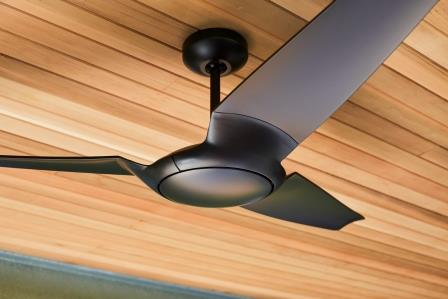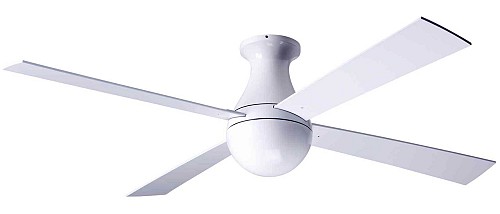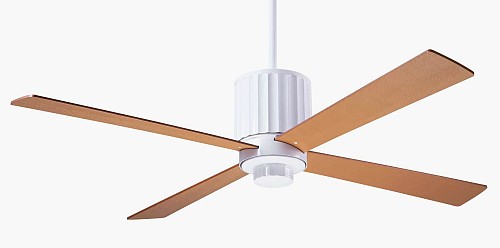Bedroom Ceiling Fans: Here's What You Need To Know
 Would you like to sleep comfortably cool while saving electricity? Consider bedroom ceiling fans. Not only practical and affordable, these devices are also energy-efficient. And in contrast with their former fussily fusty or starkly simple appearance, today’s bedroom ceiling fans add a touch of elegant style and, in some cases, a cozy layer of ambient lighting.
Would you like to sleep comfortably cool while saving electricity? Consider bedroom ceiling fans. Not only practical and affordable, these devices are also energy-efficient. And in contrast with their former fussily fusty or starkly simple appearance, today’s bedroom ceiling fans add a touch of elegant style and, in some cases, a cozy layer of ambient lighting.
To make matters more interesting, fans are even the subject of some controversy.
Intrigued? Read on.
Cost. Ceiling fans, as a rule, are relatively inexpensive to buy and to install. Nor will you have the expense and hassle of adding a dedicated circuit, as you might with air conditioner installation.
Fans are also cheap to run, consuming only a few dollars’ worth of electricity per year. Check out this Department of Energy cost calculator for a general idea; more specific energy cost information will be indicated on the label of the fan you buy.
Installation. Find a professional – a handyman or an electrician – to install your fan. Modern bedroom ceiling fans are lighter weight than they used to be, but still must be securely attached to a metal (not plastic) junction box. You might want the pro to install a wall control, as well.
Energy Savings. In mild climates or seasons, you can run your fan in place of air conditioning and consume just a fraction of the energy. And when the weather gets hotter, use it to circulate your A/C’s cooled air more effectively; you’ll be able to set your thermostat 4 degrees higher and stay just as cool.
Bedroom ceiling fans are equally useful for cutting heating costs (not that anyone wants to think about winter right now) because they reclaim and circulate warmed air that tends to collect up near the ceiling.
Size. For aesthetic reasons, it’s best to select a fan that’s in proportion to the bedroom and fits the ceiling space available. You do not want the appliance to interfere with built-in shelving, ceiling coffers, or other features.
However ... here’s where the controversy comes in. A spokesperson at the Modern Fan Co mentioned that both homeowners and fan suppliers often go for a “Big Gulp” scenario, believing that bigger is necessarily better. He explained that it’s really not the fan size or number of blades which should be your first, second, or even third consideration when choosing a fan. Motor strength and blade pitch are major factors in cooling power.
In fact, a smaller-diameter ceiling fan moves air at a higher velocity; it just doesn’t distribute it across as broad an area. This is relevant in your choice of bedroom fan --- when you go to bed at night, you want efficient cooling, but you don’t need air to be circulated throughout the entire room.
Height and Drop. Building code requires a minimum 7-foot clearance between the fan blades and your floor. So it’s okay to install fans on ceilings as low as 8 or even 7 ½ feet (found in some older homes). You just need to choose the right fan -- a compact, flush-mounted model.
Of course, higher ceilings will allow a drop for a greater return of air, which makes for more efficient cooling. 10-12 inches lower than ceiling height is generally recommended.
Style. Fan styles have grown simpler, cleaner-lined, following modern design trends. That doesn’t mean dull! The right fan will add visual interest to an often-neglected area -- your ceiling. Choose styles to complement, rather than contrast with, your decor; bedroom ceiling fans should be a relaxing, harmonious element.
My personal favorite? White bedroom ceiling fans with walnut blades. They feel light, fresh, and modern.
Noise level. Supersensitive souls may worry that the hum of a fan motor will interfere with sleep. Fortunately, today’s high-quality bedroom ceiling fans are surprisingly quiet, and truly silent when powered by direct current (DC) instead of the traditional alternating current (AC).
Maintenance. Dust bedroom ceiling fans' mounting and blades regularly. (The hack of pulling an old pillowcase over each blade in turn removes dirt without spreading it all over your bed and floor. ) This easy maintenance minimizes allergic reactions, and helps keep the blades working efficiently, too.
Laura Firszt writes for networx.com.
Looking for a Pro? Call us (866) 441-6648

Handyman Average Costs
Handyman Services Experiences

Lawn Repair: Contractor Followup To My DIY Prep Got The Job Done

Tree Removal For The Last Part Of A Poor Old Mulberry











